Bebop, Jazz Manhood and “Piano Shame”
By Guthrie P. Ramsey, Jr.
 In sixth or seventh grade, a time of life when most guys my age were trying on their swagger, I was walking back home from a practice session at a buddy’s house that was furnished with a piano. Along the way, my instruction book clutched under my arm like any average nerd, I passed some classmates who asked with simple curiosity and no malice, what was up, where I had been. “Practicing my music,” I said, probably looking serious, deep in my thoughts, and studiously absent-minded, as some people say they remember me. “Cool. What do you play?” somebody asked. Before I knew it, the word “sax” fell out my mouth.
In sixth or seventh grade, a time of life when most guys my age were trying on their swagger, I was walking back home from a practice session at a buddy’s house that was furnished with a piano. Along the way, my instruction book clutched under my arm like any average nerd, I passed some classmates who asked with simple curiosity and no malice, what was up, where I had been. “Practicing my music,” I said, probably looking serious, deep in my thoughts, and studiously absent-minded, as some people say they remember me. “Cool. What do you play?” somebody asked. Before I knew it, the word “sax” fell out my mouth.
I don’t know exactly where I had gotten this information, but it was clear to my adolescent, late-blooming ass that claiming the saxophone would make me look more swagger-full than the truth—that I was thoroughly enthralled with the piano. And that my family couldn’t afford one at the time so I practiced however I could, mapping out homes in my black, working-class neighborhood with an instrument. It was, indeed, another time when a kid with ambitions larger than his immediate circumstances could get a boost from the “Village.” I passed what I apparently perceived as the “coolness test,” relieved that nobody in the group pointed out that I was not actually carrying a saxophone. The heroic performance of self-assured, cool manhood would finally settle in by late adolescence, as admiring women would quietly pass their phone numbers after a stage show, other musicians would seek me out for gigs, and academic opportunities unavailable to those with picture perfect cross-over moves and jump shots began to open up. Although I’ve lost the need to lie about music for the sake of traditional manhood, the historical and social grounding of my childhood “piano shame” is a complex matter about masculinities worthy of discussion.
In a media-scape saturated with electronic beats, auto-tuned voices and urban contemporary styles grounded in hip-hop production sensibilities, contemporary popular music commands the attention of many commenters concerned with gender analysis. Jazz, for the most part, is not seen as a site worthy of such investigations, particularly in social media. Yet it’s fascinating to consider bebop (or modern jazz) and what people heard in it as a gendered sonic field doing extraordinary cultural work in the quest for masculinity. Artists such as Amiri Baraka and Quincy Jones have confessed their intense identification with bebop’s experimental language as young men, describing it as more of lifestyle than a musical choice, much like hip-hop devotees. It may surprise some readers that like the lyrics of rap, non-representational instrumental music such as jazz can be analyzed with respect to its registration of historically contingent social energies like masculinity in potent and pleasurable ways.
Much of this energy occurs at the borders of a perceived musical style or genre. And here is where the case for gender study gets compelling with regard to jazz and bebop. Feminist musicologist Susan McClary argues that “genres and conventions crystallize because they are embraced as natural by a certain community: they define the limits of what counts as proper musical behavior.” Thus, the occasions of stylistic disruption—those times when jazz musicians seemed to push the limit of acceptable generic expectations like they did in bebop—are important sites in which to tease out gendered meanings: in the space between convention and innovation exists the stories of power struggle through experimentation. In other words, as musicians push against a listening community’s acceptable codes of musical behavior, they are usually articulating who they believe they are in the world through displays of musical prowess, stylistic challenge, and experimentation. All of this has circulated, by the way, within a network of ideologies in which popular and “Other” cultures were historically rendered as “feminine” or non-prestigious when compared to an intentionally “butched-up” western art music discourse, illustrating yet another example of how musicality and gender are diligently policed performance fields.
What are some of the historical politics of “jazz-manhood”?
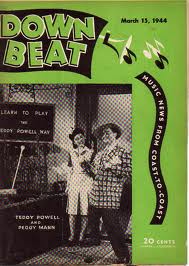 Writing in 2001, in the context of a wave of scholarship named the New Jazz Studies, Sherrie Tucker argued persuasively for the inclusion of gender in jazz studies in many publications. Rather than seeing her project as solely aimed at recovering the history of women participating in jazz, Tucker suggested a more radical strategy. She pushed for the placement of jazz studies over the field of gender as a way to understand how the latter structures all aspects of the jazz field. While the compensatory histories of women in jazz are useful and long overdue, the critical study of gender in jazz studies should involve more than the “women were there, too” framework. All this work demands that we see jazzmen as possessing gendered identities, too: the music was an activity in which they negotiated their sense of manhood in American society. Although we’ve come a long way since the days when women’s bodies were used as a sign of music being “not real jazz” in publications such as Down Beat, the time is ripe for critical expansion. As Tucker argued, we “need to conceive of gender not as a synonym for women, and not just as a critical description of sex and gender roles, but as one of the primary fields ‘within which or by means of which power is articulated.’
Writing in 2001, in the context of a wave of scholarship named the New Jazz Studies, Sherrie Tucker argued persuasively for the inclusion of gender in jazz studies in many publications. Rather than seeing her project as solely aimed at recovering the history of women participating in jazz, Tucker suggested a more radical strategy. She pushed for the placement of jazz studies over the field of gender as a way to understand how the latter structures all aspects of the jazz field. While the compensatory histories of women in jazz are useful and long overdue, the critical study of gender in jazz studies should involve more than the “women were there, too” framework. All this work demands that we see jazzmen as possessing gendered identities, too: the music was an activity in which they negotiated their sense of manhood in American society. Although we’ve come a long way since the days when women’s bodies were used as a sign of music being “not real jazz” in publications such as Down Beat, the time is ripe for critical expansion. As Tucker argued, we “need to conceive of gender not as a synonym for women, and not just as a critical description of sex and gender roles, but as one of the primary fields ‘within which or by means of which power is articulated.’
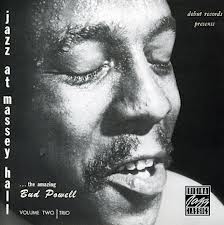 An intense, aggressive virtuosity within and on top of the structures of American popular song constituted the heart of the bebop aesthetic. One scholar called this aesthetic a “politics of style,” a concept describing the specific mode of cultural work the music achieved in its time. The young black men in the bebop movement found in its sounds and politics a patriarchal, heroic performance space, one that became the new musical language of “jazz manhood.” One such musician was pianist Bud Powell (1924-66). The subject of my new book, The Amazing Bud Powell: Black Genius, Jazz History, and the Challenge of Bebop, he was certainly “the man” of bebop piano. He was a talented but introverted boy whose musical skills and seriousness about his craft paved the way for his meteoric rise in the New York jazz world. According to various people who knew Powell in his younger years, he had become enamored with the modernist sound elements in bebop before he was twenty years old. Former acquaintances shared stories of an increasingly impatient young man who sought out competitive situations in which he could show off his technical command in the new style in the tradition of the stride piano contests of previous generations. Otherwise soft-spoken and withdrawn, in purely musical settings Powell was known to want his own way—never with violence, but often with the seething insistence of someone with little regard for the feelings of others. Whether he was refusing to play a bandleader’s desired number or brusquely removing another pianist (or competitor) from the instrument to brandish his own “weapons,” Powell’s single-minded, almost myopic focus on showcasing his own gifts was often excused by others as harmless, youthful unruliness. But his exposure to alcohol, drugs, a nocturnal lifestyle that had interrupted his education, and the overall phallocentric vibe of the scene no doubt caused the sheltered prodigy to grow up and man up fast—both artistically and otherwise—although one can surmise from various accounts that Powell was still very much an adolescent emotionally.
An intense, aggressive virtuosity within and on top of the structures of American popular song constituted the heart of the bebop aesthetic. One scholar called this aesthetic a “politics of style,” a concept describing the specific mode of cultural work the music achieved in its time. The young black men in the bebop movement found in its sounds and politics a patriarchal, heroic performance space, one that became the new musical language of “jazz manhood.” One such musician was pianist Bud Powell (1924-66). The subject of my new book, The Amazing Bud Powell: Black Genius, Jazz History, and the Challenge of Bebop, he was certainly “the man” of bebop piano. He was a talented but introverted boy whose musical skills and seriousness about his craft paved the way for his meteoric rise in the New York jazz world. According to various people who knew Powell in his younger years, he had become enamored with the modernist sound elements in bebop before he was twenty years old. Former acquaintances shared stories of an increasingly impatient young man who sought out competitive situations in which he could show off his technical command in the new style in the tradition of the stride piano contests of previous generations. Otherwise soft-spoken and withdrawn, in purely musical settings Powell was known to want his own way—never with violence, but often with the seething insistence of someone with little regard for the feelings of others. Whether he was refusing to play a bandleader’s desired number or brusquely removing another pianist (or competitor) from the instrument to brandish his own “weapons,” Powell’s single-minded, almost myopic focus on showcasing his own gifts was often excused by others as harmless, youthful unruliness. But his exposure to alcohol, drugs, a nocturnal lifestyle that had interrupted his education, and the overall phallocentric vibe of the scene no doubt caused the sheltered prodigy to grow up and man up fast—both artistically and otherwise—although one can surmise from various accounts that Powell was still very much an adolescent emotionally.
What were the technical specifics of this language of jazz manhood in which Powell would immerse himself? And in which historical and material notions of the gender/music relationship were this language and its social environment grounded? What were the terms of Powell’s social contract as a black virtuoso in the bebop scene?
Although historians may still debate whether bebop was a revolutionary or an evolutionary style development, agreement exists on its core qualities. Most prominently, bebop consists of an enriched melodic, harmonic, and rhythmic vocabulary that required astute musicianship and a “virtuosic bravado.” Bebop’s most significant contribution to the jazz tradition was in the area of improvisation, both in soloing and accompanying. Improvised bebop solos shared the melodic and rhythmic character of many bebop themes, including a frequent use of asymmetrical phrase structures; a harmonic vocabulary that employed ninths, elevenths, and thirteenths; and chromatic melodic lines that often stressed the weak beats of the measure. Swing, bebop’s immediate stylistic predecessor, used more uniform phrases, structures, and accents and had less varied rhythmic patterns and less emphasis on harmonic dissonance.
 Frontline virtuosos such as Charlie Parker and Dizzy Gillespie attracted the lion’s share of public attention as they wove intricate solos before awestruck listeners. Yet much of the musical enchantment of bebop emanated from its new conception of accompaniment in the rhythm sections, which created brilliant sonic tapestries supporting the dramatic solos. Pianists, drummers, guitarists, and bassists supported bebop’s themes and solos with a rich and sometimes cacophonous mix of timbres, harmonic substitutions, and polyrhythmic accents that complemented and at the same time challenged the soloists. All the while, they maintained the fixed rhythmic pulse that linked the music to traditional black dance music forms. Bebop innovations brought about a heightened tension in melody, harmony, and rhythm that was, on some levels, a break with earlier styles of jazz. Thus, bebop musicians struck a balance that both satisfied modernist ideals of musical “complexity” and situated their music conceptually under the umbrella of black Atlantic musical traditions. The dynamic grooves struck by modern jazz musicians such as Powell were as central to the music’s influence as the work of frontline soloists. It was there—in the midst of the give and go of rhythms, subtle timbral shifts, and cagey harmonic embellishments—that audiences were able to discern that a new day had dawned in popular music, and that new communities and identities were being formed as well.
Frontline virtuosos such as Charlie Parker and Dizzy Gillespie attracted the lion’s share of public attention as they wove intricate solos before awestruck listeners. Yet much of the musical enchantment of bebop emanated from its new conception of accompaniment in the rhythm sections, which created brilliant sonic tapestries supporting the dramatic solos. Pianists, drummers, guitarists, and bassists supported bebop’s themes and solos with a rich and sometimes cacophonous mix of timbres, harmonic substitutions, and polyrhythmic accents that complemented and at the same time challenged the soloists. All the while, they maintained the fixed rhythmic pulse that linked the music to traditional black dance music forms. Bebop innovations brought about a heightened tension in melody, harmony, and rhythm that was, on some levels, a break with earlier styles of jazz. Thus, bebop musicians struck a balance that both satisfied modernist ideals of musical “complexity” and situated their music conceptually under the umbrella of black Atlantic musical traditions. The dynamic grooves struck by modern jazz musicians such as Powell were as central to the music’s influence as the work of frontline soloists. It was there—in the midst of the give and go of rhythms, subtle timbral shifts, and cagey harmonic embellishments—that audiences were able to discern that a new day had dawned in popular music, and that new communities and identities were being formed as well.
These new musical conceptions, together with a new social contract with the listening public, signaled that jazz had experienced a generic shift; that it had, in other words, become something new. Because social identities are “made” and often communicated to others within the context of expressive culture, one can look to concepts such as gender and genius to interpret modern jazz’s generic development.
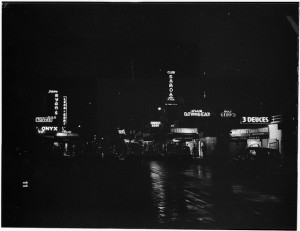 In his discussion of gender and jazz in the 1930s, Patrick Burke argues that white masculinity in this context was constituted at “the tangled intersection of ideas about race, gender, labor, and musical practice.” In the after-hours cultural space of 52nd Street’s Onyx Club, a popular speakeasy, white male musicians negotiated their own sense of identity through several means, including their emulation of stereotypes about black musical spontaneity and “hotness,” the marginalization of women, and their antagonistic views about a supposed antithetical relationship between their lucrative gigs and “authentic expression.” These musicians were not exceptions in this regard: many throughout the history of the music have negotiated their identities in the jazz world. In this particular social setting, racial ventriloquism and anticommercial sentiments were rehearsed within a culture of urban bachelorhood. This was a powerful cocktail indeed.
In his discussion of gender and jazz in the 1930s, Patrick Burke argues that white masculinity in this context was constituted at “the tangled intersection of ideas about race, gender, labor, and musical practice.” In the after-hours cultural space of 52nd Street’s Onyx Club, a popular speakeasy, white male musicians negotiated their own sense of identity through several means, including their emulation of stereotypes about black musical spontaneity and “hotness,” the marginalization of women, and their antagonistic views about a supposed antithetical relationship between their lucrative gigs and “authentic expression.” These musicians were not exceptions in this regard: many throughout the history of the music have negotiated their identities in the jazz world. In this particular social setting, racial ventriloquism and anticommercial sentiments were rehearsed within a culture of urban bachelorhood. This was a powerful cocktail indeed.
How might the setting of the Onyx Club help us understand the world of black male musicians who, like Powell, played bebop at a later historical moment? As they operated with somewhat different social standings, white and black masculinities in the musical world of the 1940s shared little save the marginalization of female musicians, especially instrumentalists. Black musicians negotiated their immediate social worlds to procure for themselves some of the traditional advantages of male power—earning wages, spectacle, and hegemony over women—in the context of a growing black, urban, and artistic proletariat. Significant work in gender and music has, of course, been developed in studies of western art music and popular music studies. When we work with those insights into jazz and black music specifically, we must account for their similarities to and differences from both of those realms.
By the early 1900s, a “classical sphere” network based on European traditions of compositions was clearly in place in America, and it included “performing groups, concert halls, conservatories, and enough public interest in these institutions to support them financially.” Involvement with classical music became at this time a set of activities—performance, promotion, and audience participation—in which “men and women articulated their anxieties about changing gender roles.” As women pushed for fulfilling lives outside the home and the domestic realm, careers in music provided new alternatives: professional women musicians became emblematic of women’s desires for more satisfying public lives. Many formed civic clubs in which they exercised control over the community’s musical life and other realms of the public sphere. For their part, men tempered their muses by emphasizing their enthusiasm for “boxing, wrestling, or other similar activities, or by expressing their interests [in music] solely as a civic and husbandly duty.” Gender distinctions were a pressing concern, and America’s classical music world was a potent place in which to struggle with them, indeed, to “arbitrate anew the meanings of masculinity and femininity” in modern industrialized society.
During these same years, jazz emerged as a musical form distinct from classical-sphere music and its concerns, replete with varying ideas about gender, class, and, of course, race. Jazz became part of the popular sphere, and, as Richard Crawford has noted, “popular entertainment was well on its way to becoming modern ‘show business.’ And the workings of this new entertainment industry depended on a new approach to creating and marketing popular song.” The elements of this emerging structure created a space for a wide range of social formations. For example, it provided opportunities to work out gender roles in the public sphere, and African Americans were crucial in these new formations because the industry offered one of the precious few opportunities for them to be considered something more than servants and menial workers with the lowest pay.
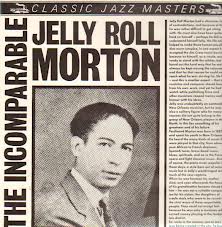 The great jazz composer and pianist Jelly Roll Morton’s discussion of his childhood musical attitudes and aspirations in early-twentieth-century New Orleans gives us a snapshot of how race, gender, and class shaped his thinking. As Creoles, his class-conscious parents wanted him to play the “proper music heard at the French Opera House” and not popular music. As a child, he heard a man play a classical recital, and he was attracted to the music. But there was a problem. The gentleman had “long bushy hair, and, because the piano was known in our circle as an instrument for a lady, this confirmed for me my idea that if I played the piano I would be misunderstood.” In his own words, Morton “didn’t want to be called a sissy.” Because of this aversion to one of the prevalent social meanings of the piano in his world, he decided to study other instruments, “such as violin, drums, and guitar, until one day at a party I saw a gentleman sit down at the piano and play a very good piece of ragtime. This particular gentleman had short hair and I decided then that the instrument was good for a gentleman same as it was for a lady.”
The great jazz composer and pianist Jelly Roll Morton’s discussion of his childhood musical attitudes and aspirations in early-twentieth-century New Orleans gives us a snapshot of how race, gender, and class shaped his thinking. As Creoles, his class-conscious parents wanted him to play the “proper music heard at the French Opera House” and not popular music. As a child, he heard a man play a classical recital, and he was attracted to the music. But there was a problem. The gentleman had “long bushy hair, and, because the piano was known in our circle as an instrument for a lady, this confirmed for me my idea that if I played the piano I would be misunderstood.” In his own words, Morton “didn’t want to be called a sissy.” Because of this aversion to one of the prevalent social meanings of the piano in his world, he decided to study other instruments, “such as violin, drums, and guitar, until one day at a party I saw a gentleman sit down at the piano and play a very good piece of ragtime. This particular gentleman had short hair and I decided then that the instrument was good for a gentleman same as it was for a lady.”
Fletcher Henderson’s educated parents stressed piano lessons in the home as a crucial part of a thorough, well-rounded education in the Deep South at a time (the early twentieth century) when the instrument was a symbol of uplift and middle-class respectability. Everyone in the Henderson household read music and played the piano, although the repertoire was circumscribed to “classical and church music.” Because of this background, the pull of financial gain and masculinist success was strong and inevitable. Henderson would eventually forego his plans to earn a master’s degree in chemistry at Columbia University to pursue a successful career in dance music. The music industry at this time, together with a heightened African American cultural presence in American consciousness, provided what Jeffrey Magee has called “unprecedented opportunities for African Americans with ambition and talent.” Henderson clearly possessed both, and by 1923, three years after he arrived in New York, he was thoroughly ensconced in the city’s popular musical world.
One of his activities involved the new blues craze of the 1920s. Although he was not a blues or jazz musician per se when he came to New York, Henderson accepted the professional challenges of this environment, one far removed from his sheltered upbringing in the upper crust of the new black South. He enjoyed the money, notoriety, and popularity with the ladies. Indeed, the music industry became a promising alternative realm for black men to make new meanings in masculinity, even well-educated, prepared men such as Henderson.
Here it is important to remember that the popular sphere also gave women a platform to attain the empowering visibility and wage-earning potential that defined traditional masculinities. The blues industry in particular provided women with their own stage on which to publicly negotiate gender roles. The rise of black popular culture was part of a larger shift in the 1920s that wrested the sole responsibility for black progress and representation away from the educated, literate men of the “Talented Tenth.” In her study of 1920s blueswomen, Hazel Carby argues that black power and representation were up for grabs across the board—not just in the realm of music–as various constituencies jockeyed to publicly claim that their own group best represented “the experience of the race.” Thus black musical masculinity was performed in a larger cultural frame of diverse intra–African American struggles for social power, including but not limited to both men and women actively stepping out of traditional subservient roles.
We see multiple shifts occurring here. Popular music became an important province for African Americans, and classical music solidified their own idea of authenticity. Each realm was an important cultural territory for negotiating power through gendered meanings, and they would collide in the bebop movement. For black men, popular culture provided an arena of accomplishment that was thoroughly rooted in wage earning, visibility, and creative expression. Since the public aspect of popular culture remained, for the most part, segregated, it provided little threat to the “separate but equal” doctrine that policed race relations. In other words, there existed—on the surface, at least—few risks of direct sexual, financial, or social competition with white men.
The ascendancy of popular culture tended to flatten out class distinctions within the black community as well, as black middle-class musicians flocked to the unprecedented opportunities and prestige that it offered. Apparently, what the cultural arbiters of good taste considered “low-brow” was a shot at upward mobility for these “Others.” What was perceived as a threat to virile masculinity and good class standing by Jelly Roll Morton’s generation—particularly seen in his apparent view that “classical” music posed a threat to perceptions of his masculinity—was a springboard to becoming a sex symbol and iconic success for Duke Ellington, Willie “the Lion” Smith, and other, later musicians. It is within this historical, social, and material grounding that bebop and the new idea of “jazz manhood” emerged.
With all of these histories swirling around music, gender and sexuality, it’s easy to understand why I bailed on my beloved piano and claimed an instrument in which I had little interest. Ideas about manhood and musicality have always been fraught, fickle and powerful.
_____________________________________________
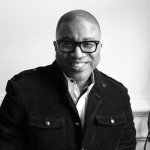 Guthrie P. Ramsey, Jr. is the Edmund J. and Louise W. Kahn Term Professor of Music and Africana Studies at the University of Pennsylvania. He is the author of Race Music: Black Cultures from Bebop to Hip-Hop and The Amazing Bud Powell: Black Genius, Jazz History and the Challenge of Bebop. In 2012, his band released The Colored Waiting Room, a recording of original music blending jazz, rhythm and blues, gospel, neo-soul, and classical. Ramsey is the founder popular music blog, Musiqology.com, which is read around the world.
Guthrie P. Ramsey, Jr. is the Edmund J. and Louise W. Kahn Term Professor of Music and Africana Studies at the University of Pennsylvania. He is the author of Race Music: Black Cultures from Bebop to Hip-Hop and The Amazing Bud Powell: Black Genius, Jazz History and the Challenge of Bebop. In 2012, his band released The Colored Waiting Room, a recording of original music blending jazz, rhythm and blues, gospel, neo-soul, and classical. Ramsey is the founder popular music blog, Musiqology.com, which is read around the world.




4 Comments